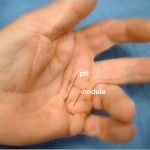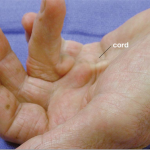Dupuytren’s Disease is an abnormal thickening of the tissue, or fascia, just beneath the skin. This thickening occurs in the palm and can extend into the fingers. You may be able to feel the various thickenings in your hand – cords, nodules, or pits. The cord thickenings can cause the fingers to bend into the palm.


Cause of Dupuytren’s Contracture
There is not a known, direct cause of Dupuytren’s disease. It is most common in men over age 40, and individuals of Northern European descent. Dupuytren’s is sometimes referred to as a “Disease of the Vikings.”
Treatment for Dupuytren’s Contracture
In mild cases exhibiting no loss of hand function, observation of the progression is all that is necessary. At the point in which the palm thickenings cause the fingers to bend in towards the palm, treatment may be required. One indication for treatment commonly used is the “table top test,” where a patient is unable to place the palm of the hand flat on a table. Several treatment options are available:
Xiaflex
XIAFLEX is a prescription medicine that’s injected directly into the cord that is causing the finger to be bent. It’s the first and only FDA-approved nonsurgical procedure – and it can be done right in the doctor’s office, with no general anesthesia required to administer. XIAFLEX should be administered by a doctor experienced in injection procedures of the hand and in the treatment of Dupuytren’s contracture.
XIAFLEX is the first and only FDA-approved nonsurgical treatment option proven in clinical studies to work in adults with Dupuytren’s contracture when a “cord” can be felt. In two studies, XIAFLEX helped many people with Dupuytren’s contracture achieve straight or nearly straight fingers and improve their range of motion in the affected finger.
Xiaflex is a great treatment option in certain cases. Recovery is much quicker than surgery and can restore hand function. Not everyone is a candidate, so it is important to be evaluated by a hand specialist.
Dupuytren’s Contracture Surgery
Sometimes surgery is the best treatment option. A partial fasciectomy involves removal of the diseased tissue, allowing the fingers to straighten out. There are many variations of the location and effect of Dupuytren’s cords, and an individualized surgery plan is important depending on these variations. After surgery, the hand is placed in a splint to keep the fingers straight. Early motion is important and will be encouraged within the first week after surgery. A splint will be worn at night for approximately 6 months following surgery.
Pictures modified from ASSH (www.assh.org)
